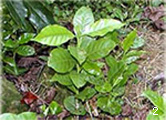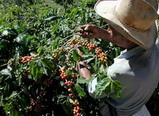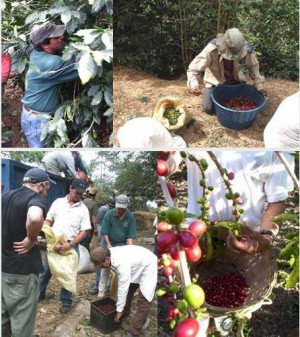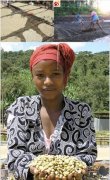The birth of Fine Coffee Culture and Common sense Coffee beans
The Life of Coffee Tree
Coffee trees take 3-5 years from planting to fruiting. 6-10 years of coffee trees are the most likely to bear fruit, about 15-20 years, is the harvest period. Coffee trees are usually bred in nurseries and grow into saplings, and then moved to coffee farms a year later, in full compliance with the way the Arabs planted and cultivated coffee trees. In the first four or five years of its growth, the coffee tree will continue to take root downward, develop its trunk upward, and develop its branches into an umbrella shape so that it can bear rich fruit in the future.
If the coffee is exposed to direct sunlight and the leaf temperature rises, the stomata will close, unable to absorb carbon dioxide, and the coffee tree will stop growing. Some taller trees will be planted next to the coffee tree to avoid being exposed to the sun for a long time. It is usually tropical cash crops such as bananas, betel nuts and so on. Banana and other cash crop trees not only shade, but also through photosynthesis, produce carbohydrates for coffee tree growth energy. As bananas grow fast and can be used as a by-product income, it can be said that coffee and bananas are good brothers of tropical cash crops.
Coffee trees can only grow in the tropics and subtropics. Coffee trees can grow in different climates, soils, elevations and rainfall in the middle of the "coffee belt". Coffee trees thrive in the hot and humid canyons and forest rainforests of Africa; it still produces high-quality coffee beans in cold, foggy, windy Central America; and in the Caribbean, where the climate is changeable, drought and torrential rain, it still blossoms and bears fruit. These factors are the secret that coffee beans have different flavors and a wide variety.

1. Grow coffee beans 2. Coffee seedling cultivation 3. The early flowering stage of coffee tree
4. The full period of coffee flowers is 5. Coffee trees bear fruit 6. The coffee fruit is ripening gradually
One of the characteristics of a coffee tree is that its fruit can bear fruit several times a year, and another is that flowers and fruits (also known as cherries) coexist at different stages of ripening. The whole coffee harvest is swayed by the vagaries of nature. If the fruit is too ripe, the beans in it will rot. If it is not ripe enough, the beans picked will not ripen by themselves. So bean pickers often go back to the same tree several times to find ripe fruit-it takes only 2 pounds to go back and forth several times, and a typical Arabica coffee tree produces less than 5 kilograms / 11 pounds of fruit in a year. can be made into about 1 kg / 2.2 pounds of coffee beans.

7. Ripe coffee fruit 8. Coffee fruit is harvested manually. Collecting mature Coffee Cherry most of the world's coffee harvesting is hand-picked, so coffee harvesting is a labor-intensive and seasonally intensive process. Since there are both flowers and fruits on the same branch, the index finger and thumb of the collector are the best tools for collecting ripe berries. Scraping the fruit off a whole branch by hand or using an automated harvester can't tell ripe berries from green berries.

Coffee farmers who produce low-grade coffee beans like to use labor-saving methods to harvest beans, but in this way, because the quality is not pure, it impairs the flavor of coffee and lowers the grade of coffee. The way to pick coffee beans in some parts of Africa is to shake coffee trees, shake the fruit off the ground, and pick it up from the ground before the fruit is injured and rotten. Secondary coffee is produced in most parts of Brazil, where coffee is picked by plucking all the leaves, flowers, overheated and green fruits from the branches at a time, and it takes two years for such damaged coffee trees to return to normal.
Automated harvester large-scale automated harvesting process
When the mature bright red coffee "cherry" is to be turned into a series of raw coffee beans, it needs to go through a series of processing procedures, and the next issue will introduce the processing process in detail.
Important Notice :
前街咖啡 FrontStreet Coffee has moved to new addredd:
FrontStreet Coffee Address: 315,Donghua East Road,GuangZhou
Tel:020 38364473
- Prev

The storm in the coffee cup (middle) Ethiopia's sad appeal
Ethiopia, a poor country, is preparing to fight a century-old lawsuit against Starbucks, a rich country, which has attracted global attention. Ethiopia plays the sad card, and the global media and humanitarian organizations are almost one-sided to the weak. Egypt cites Starbucks 'best-selling Shirkina Sun-Dried Sidamo as an example of the bitterness of coffee farmers: Southern Ethiopia
- Next

General knowledge of Fine Coffee Culture emotional Coffee Culture in Vienna
Coffee is something that Viennese enjoy talking about and are quite proud of. The Viennese even compare it with music and waltz, which is called the three treasures of Vienna, which shows the relationship between Viennese and coffee. Some people say that Vienna is a five-step coffee, which may be an exaggeration by the poet, but it is true that there are a large number of Vienna cafes. Coffee kiosks for people to drink standing up from street corners,
Related
- How did the Salvadoran coffee industry develop in Central America?
- What exactly does the golden cup extraction of coffee mean?
- The Origin of Coffee flower
- [2023 Starbucks World Earth Day] there are more meaningful things besides free Starbucks coffee!
- What kind of coffee is there in Spain? 9 Flavors of Spanish Coffee
- Aromatic African coffee| Kenya's coffee culture and historical production area
- Liberica Coffee Bean knowledge: the characteristics of Liberian Coffee beans of the three original species of Coffee beans
- The origin and formula of Spanish latte introduces the taste characteristics of Bombon coffee in Valencia, Spain.
- How to adjust the solution of over-extracted coffee
- What is the tasting period of coffee beans? What is the period of coffee and beans? How should coffee wake up and raise beans?

